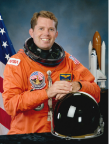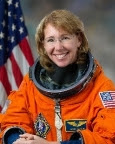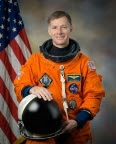Veteran NASA Astronauts David Leestma, Sandy Magnus and Chris Ferguson to be Inducted at Kennedy Space Center Visitor Complex, June 2022
Veteran astronauts David Leestma, Sandy Magnus and Chris Ferguson, who have all demonstrated outstanding accomplishments in furthering NASA’s mission of exploration and discovery, have been selected to receive one of the highest honors in their industry.
In June, they will be inducted into the United States Astronaut Hall of Fame®, joining an elite group of only 101 individuals to have received this esteemed honor. The announcement was made by Curt Brown, board chairman of the Astronaut Scholarship Foundation, which oversees the selection process.
An official ceremony and gala will take place at Kennedy Space Center Visitor Complex on June 11, 2022. Set against the historic and stunning backdrop of the Space Shuttle Atlantis®, the ceremony will be attended by space enthusiasts, community leaders, and a number of astronaut legends. Following the induction, the newest Hall of Fame members will be celebrated at an evening black-tie event hosted by the Astronaut Scholarship Foundation.
“Unfortunately, the global pandemic delayed our 2020 induction process, resulting in a year without new inductees. Our class of 2020 veteran astronauts – Pamela Melroy, Scott Kelly and Michael Lopez-Alegria – were officially inducted at a rescheduled ceremony in November 2021,” said Brown. “As we embark on a new era of space travel and interplanetary exploration, we are pleased to resume this annual program – as scheduled – and welcome these accomplished individuals into the United States Astronaut Hall of Fame. All three have demonstrated the characteristics that define a Hall of Famer: heroism, commitment and bravery.”
Leestma, Magnus and Ferguson all have had distinguished careers, centered around their love of space and science:
Capt. David Leestma, STS-41G, STS-28, STS-45
 |
David Leestma (Capt., USN, ret.) was selected as an astronaut in 1980 and subsequently flew three space shuttle missions – STS-41G, STS-28 and STS-45. He performed a wide variety of mission tasks, gaining invaluable experience in human spaceflight.
Leestma’s three space flights gave him a unique background (extavehicular activity, remote manipulator system operations, Department of Defense flight operations, on-orbit contingency operations, Spacelab operations, international liaison, vehicle/systems operator, on-orbit command) that enabled him to perform in a variety of NASA executive positions after retiring from the Astronaut Office and the Navy.
He was selected as the Director, Flight Crew Operations, responsible for the astronaut office and Johnson Space Center (JSC) aircraft operations. During his tenure 41 space shuttle flights and seven shuttle-MIR flights were successful and safely flown, three new astronaut classes were selected, International Space Station (ISS) assembly operations were begun, and he oversaw the requirements, development and in-house modification of the NASA T-38A fleet to the T-38N.
He was subsequently assigned as the Deputy Director, Engineering, in charge of the JSC Government Furnished Equipment (GFE) projects for the ISS. Leestma then became the JSC Program Manager for the Space Launch Initiative responsible for all JSC work related to the development of a new launch system. He also served as the Assistant Program Manager for the Orbital Space Plane, responsible for the vehicle systems and operation of a new crewed space craft.
He continued his career at NASA serving in a variety of senior executive positions that allowed him to adhere to his vision of human exploration beyond low earth orbit and cultivate the necessary relationships across the Agency and internationally to garner the support for future exploration programs. For his accomplishments he was twice awarded the Presidential Rank of Meritorious Executive.
Leestma retired from NASA in 2014 after 47 years of government service (35 of them with NASA).
A 1971 graduate of the U. S. Naval Academy, Leestma obtained his master’s degree in aeronautical engineering from the Naval Postgraduate School and attended Navy flight school, where he earned his wings and was assigned to fly the F-14A Tomcat.
He served as an operational flight crew member for three overseas deployments and later as an Operational Test Director for the F-14A.
Dr. Sandy Magnus, STS-112, STS-126, STS-135
 |
Selected to the NASA Astronaut Corps in April 1996, Dr. Sandra H. “Sandy” Magnus flew in space on the STS-112 shuttle mission in 2002, and on the final shuttle flight, STS-135, in 2011. In addition, she flew to the International Space Station on STS-126 in November 2008, served as flight engineer and science officer on Expedition 18, and returned home on STS-119 after four and a half months on board.
Following her assignment on Station, she served at NASA Headquarters in the Exploration Systems Mission Directorate. Her last duty at NASA, after STS-135, was as the deputy chief of the Astronaut Office. While at NASA, Magnus worked extensively with the international community, including the European Space Agency and the Japan Aerospace Exploration Agency on facility-type payloads for the International Space Station (ISS). She also spent extensive time in Russia developing and integrating operational products and procedures in preparation for the beginning of ISS operations.
After her work in Russia, she served as a capsule communicator or CAPCOM in the ISS mission control center during the initial phases of crewed missions and later worked with the Canadian Space Agency on robotics procedures for the Special Purpose Dexterous Manipulator, or Canada Arm 2. Before joining NASA, Magnus worked for McDonnell Douglas Aircraft Company from 1986 to 1991, as a stealth engineer where she worked on internal research and development and on the Navy’s A-12 Attack Aircraft program, studying the effectiveness of radar signature reduction techniques.
Currently, Magnus is the Principal at AstroPlanetview, LLC and a part time Professor of the Practice at the Georgia Institute of Technology. In addition to her work at Georgia Tech, she is a member of several technical advisory boards and is active as an independent consultant in the aerospace industry.
Prior to striking out on her own, she was the Deputy Director of Engineering in the Office of the Secretary of Defense for the Undersecretary of Research and Engineering. In that role she served as the “Chief Engineer” for the DoD establishing engineering policy, propagating best practices and working to connect the engineering community across the department.
In addition, she is the former Executive Director of the American Institute of Aeronautics and Astronautics (AIAA), the world’s largest technical society dedicated to the global aerospace profession. Prior to leading AIAA, Magnus was a member of the NASA Astronaut Corps for 16 years.
Born and raised in Belleville, Ill., Magnus attended the Missouri University of Science and Technology, graduating in 1986 with a degree in physics and earning a master’s degree in electrical engineering in 1990. She received a Ph.D. from the School of Materials Science and Engineering at Georgia Tech in 1996.
She is a member of the NASA Aerospace Advisory Panel and President of the Board of AstraFemina, a non-profit dedicated to connecting women in STEM role models to girls to inspire them to pursue STEM careers. Magnus has received numerous awards, including the NASA Space Flight Medal, the NASA Distinguished Service Medal, the NASA Exceptional Service Medal, Office of the Secretary of Defense Medal for Exceptional Public Service and the 40 at 40 Award (given to former collegiate women athletes to recognize the impact of Title IX).
Capt. Chris Ferguson, STS-115, STS-126, STS-135
 |
A retired U.S. Navy captain and former NASA astronaut, Christopher J. Ferguson was pilot of STS-115, commander of STS-126 and of the final shuttle mission, STS-135. He has logged more than 40 days in space and 5,700 hours in high-performance aircraft. He also served as deputy chief of the Astronaut Office and was spacecraft communicator (CAPCOM) for the STS-118, -120, -128 and -129 missions.
Ferguson currently is the flight crew representative for Boeing’s Commercial Crew Program. In this role, Ferguson ensures the CST-100 Starliner spacecraft and training systems meet the needs of NASA’s astronauts. In a previous role he was responsible for making sure teammates on the ground are trained and ready to support crewed missions to the International Space Station, from pre-launch to docking, and undocking to landing and recovery.
Ferguson works with NASA’s Human Exploration and Operations Directorate along with Johnson Space Center’s Engineering, Flight Crew and Mission Operations organizations and NASA’s Commercial Crew Program to ensure Boeing’s crew transportation system supports NASA’s human rating requirements. He also plays a key leadership role in the development and human-in-the-loop testing of critical system technologies.
He holds a Bachelor of Science degree in mechanical engineering from Drexel University and a Master of Science degree in aeronautical engineering from the Naval Postgraduate School. He has been recognized with numerous service awards and citations, including the Legion of Merit, Distinguished Flying Cross, Defense Meritorious Service Medal, Navy Strike/Flight Air Medal, NASA Spaceflight Medal (three), Navy Commendation Medal (three) and the Navy Achievement Medal.
U.S. Astronaut Hall of Fame
The U.S. Astronaut Hall of Fame was spearheaded more than 30 years ago by the six surviving Mercury 7 astronauts. In November 2016, a new U.S. Astronaut Hall of Fame opened at Kennedy Space Center Visitor Complex, as part of the Heroes & Legends attraction.
U.S. Astronaut Hall of Fame Induction Process and Eligibility
Each year, inductees are selected by a committee of Hall of Fame astronauts, former NASA officials, flight directors, space historians and journalists; the process is administered by the Astronaut Scholarship Foundation. To be eligible, an astronaut must have made his or her first flight at least 17 years prior to the induction year. Candidates must be a U.S. citizen and a NASA-trained commander, pilot or mission specialist who has orbited the earth at least once
About Kennedy Space Center Visitor Complex
Kennedy Space Center Visitor Complex brings to life the epic story of the U.S. space program, offering a full day or more of fun, inspiration and educational activities. Currently open with limited capacity due to COVID-19, included with admission are Heroes & Legends, featuring the U.S. Astronaut Hall of Fame® presented by Boeing (trademark?), Space Shuttle Atlantis®, Journey To Mars: Explorers Wanted, space films, the Rocket Garden, the all-new Planet Play and the Apollo/Saturn V Center. Only 45 minutes from Orlando, Fla., Kennedy Space Center Visitor Complex is open daily from 9 a.m. – 5 p.m. Admission is $57 + tax for adults and $47 + tax for children ages 3 – 11. For more information, call 877-313-2610 or visit www.KennedySpaceCenter.com.
Twitter: @ExploreSpaceKSC
facebook.com/
#LookUp
###
Media Contact:
Lauren Eisele Walbert, Sandy Hillman Communications, lwalbert@hillmanpr.com,
443-683-0294









